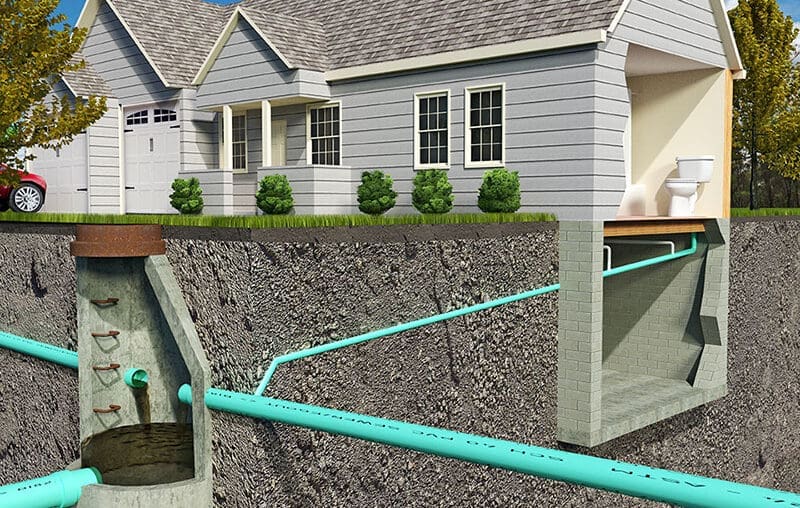From clogs to collapsed lines, your sewer line can suffer many different forms of damage that threatens to compromise both its own integrity and that of your family and pets. When this occurs, serious consequences may ensue that put their health and wellbeing at risk.
An annual sewer line inspection can help detect potential problems before they arise, whether by having it included as part of a regular home inspection or adding it on to your bill from a plumber.
Here are some plumbing issues that may indicate you may need your sewer line inspected.
Clogged Drains
Clogged drains and toilets are a sure sign that your main sewer line requires inspection, though most clogs are easily fixed using basic drain snaking and plunger techniques. If the issue persists or affects multiple drains simultaneously, it could indicate more serious trouble within your home’s main sewer system.
If this is the case, we advise having your main line regularly inspected with a camera inspection service. Doing so allows a plumber to pinpoint exactly where an issue exists without expending unnecessary time and energy on areas which don’t warrant attention.
Unusually High Water Bills
Undetected leaks can lead to significant water wastage and higher bills. Check for any visible signs of leaks, such as dripping faucets, pooling water, or damp spots around your home. Inspect both indoor and outdoor plumbing, including toilets, sinks, showers, pipes, and irrigation systems.
If you’re unable to identify the cause of your high water bills, a sewer line inspection may be needed.
Filthy Odors from Drains
Foul, gassy odors coming from toilets, sinks or other parts of your house is an obvious indicator that professional sewer line inspection may be required. Odors typically result from obstructions like clogs, cracks or misalignments in your sewer lines.
This will reduce adequate ventilation resulting in backups and other complications in its flow causing backups and backups to form. This is an indicator that it might be time for an inspection of your sewer lines and possibly repair work as soon as possible.
Floodwater flooding a sewage system can release hydrogen sulfide gasses that emit that familiar rotten egg odor – these gasses should never be ignored as they pose significant health risks.
Standing Water
Standing water in your yard can be an enormously hazardous risk. Not only is it an inviting breeding ground for pests, but the Centers for Disease Control warns it can cause Legionnaires’ disease.
If you detect standing water anywhere on your property or detect it in your basement or bathroom this should serve as an alarm bell to call in a plumber ASAP for inspection and evaluation.
Tree Root Intrusion
Tree roots naturally seek out sources of water, and if they come across small cracks or gaps in your plumbing pipes, they can infiltrate them in search of moisture. Once inside the pipes, the roots can grow and expand, causing blockages or even pipe damage.
As tree roots continue to grow inside the pipes, they can create blockages that restrict the flow of wastewater. This can lead to slow drains, gurgling sounds, or complete pipe clogs. In some cases, tree roots can exert enough pressure on the pipes to cause them to crack or collapse. This can result in severe plumbing issues, including sewage backups and leaks.
A closed-circuit TV inspection can identify where any root intrusions exist and determine the most cost-effective approach to eliminating them.
Insect Infestation
Insect infestations are another telltale sign it’s time for a sewer line inspection. Cockroaches, palmetto bugs and flies all relish in feeding off of moisture-laden organic material in broken sewer lines. These pests have no trouble infiltrating homes through cracked pipes, vent stacks or any other opening they find available – potentially contaminating food supplies with diseases spread by them and creating unhealthy living conditions for you and your family.
Sewer Backups
Sewer backups are one of the most serious problems homeowners must contend with and can be extremely hazardous to the health and well-being of their family. Contamination from human waste and other pollutants entering through sewer pipes into homes. Harmful bacteria entering through other ways can become an imminent health hazard for everyone in the house.
Clogs, cracks and leaks can all contribute to a sewer line becoming blocked up. From heavy rains and flooding to poor plumbing system maintenance in your home or even environmental factors such as poor air quality.
If your sinks take longer to drain or you hear gurgling noises when flushing the toilet, these could be early warning signs of problems in your sewer lines. It’s wise to have them checked as soon as possible in order to avoid an unpleasant backup situation later on.
Causes of sewer backup include pouring grease down drains, excessive water usage, tree roots growing into sewer lines, broken lines or placing heavy items directly on top of them. You can help mitigate these problems by having your sewer lines regularly inspected and not placing heavy objects directly on them.
Appearance Of Mildew, Mold and Water Damage
Mildew, mold, and water damage are often associated with main sewer line issues. If there’s a leak, moisture can accumulate in the affected area, creating a damp environment that promotes the growth of mold and mildew. Over time, this moisture can also lead to water damage on walls, floors, and ceilings.
A blocked or poorly functioning drainage system can cause water to back up, leading to leaks, standing water, and subsequent damage. Stagnant water provides an ideal breeding ground for mold and mildew.
What Should I Do About it?
A sewer camera inspection is important for several reasons:
Identify blockages and obstructions:
Sewer lines can become clogged or blocked due to various reasons such as tree roots, debris buildup, or structural damage. A sewer camera inspection allows professionals to visually inspect the interior of the pipes and identify any blockages or obstructions that may be affecting the flow of wastewater. By identifying these issues, appropriate measures can be taken to clear the blockage and restore proper functioning of the sewer system.
Assess the condition of the pipes: Over time, sewer pipes can deteriorate or develop cracks, leaks, or other forms of damage. A sewer camera inspection provides a detailed view of the pipe’s interior, allowing professionals to assess its condition and identify any areas that may require repairs or replacement. This proactive approach helps prevent potential sewer backups, leaks, or costly repairs in the future.
Locate potential sewer line issues: Sewer lines are often hidden underground, making it challenging to locate specific issues without excavation. A sewer camera inspection eliminates the need for unnecessary digging by providing a real-time view of the sewer line’s interior. This helps pinpoint the exact location of problems, such as pipe misalignments, fractures, or collapsed sections, allowing targeted repairs or replacements to be performed without extensive disruption to the surrounding area.
Plan efficient repairs or maintenance: By having a visual understanding of the sewer system’s condition, professionals can develop a comprehensive plan for repairs or maintenance. They can determine the most appropriate repair methods, estimate the scope of work, and allocate resources accordingly. This approach minimizes guesswork, reduces the likelihood of unexpected surprises during the repair process, and ensures that repairs are carried out efficiently and effectively.
Prevent health and environmental hazards: A malfunctioning or damaged sewer line can pose health and environmental risks. Sewage backups can lead to unsanitary conditions, foul odors, and the potential spread of harmful bacteria and pathogens.
By conducting a sewer camera inspection, potential issues can be identified and addressed promptly, preventing these hazards from occurring and safeguarding public health and the environment.
If you are considering purchasing an older home, conducting a sewer line inspection before making your purchase can be invaluable. Faulty sewer lines can be costly to repair and cause irreparable damage to landscaping features in your yard.
By inspecting beforehand you may avoid unnecessary expenses after taking ownership and potentially save yourself from major headaches in the form of unexpected repair bills later.
In summary, a sewer camera inspection is essential for diagnosing sewer line problems, assessing pipe condition, locating issues accurately, planning efficient repairs, and preventing health and environmental risks. It is a proactive measure that helps maintain the proper functioning of sewer systems and prevents potential costly repairs and disruptions.
Discount Plumbers is your go-to company for main line sewer inspection services. With our team of experienced and licensed plumbers, we can accurately diagnose any issues with your sewer line and provide you with the best solution to fix it. We use state-of-the-art equipment to ensure that the job is done efficiently and effectively. Don’t wait until you have a major sewer line problem, contact Discount Plumbers today for a thorough inspection and peace of mind.






